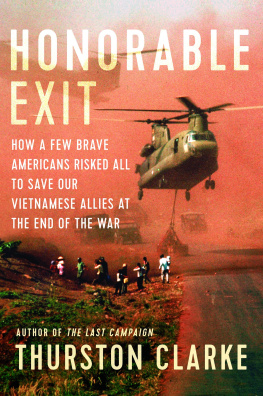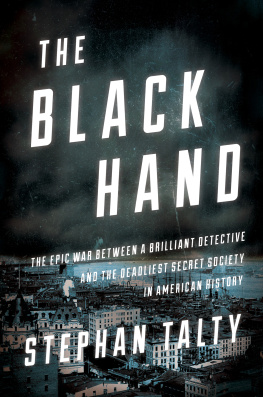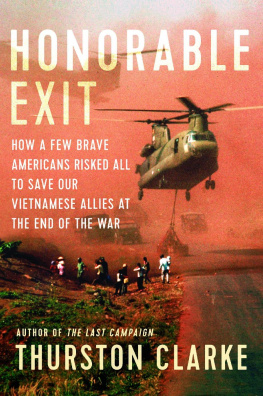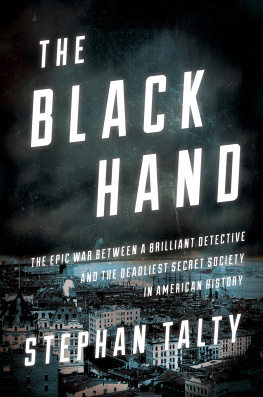THE
LUCKY
FEW



Naval Institute Press
291 Wood Road
Annapolis, MD 21402
2013 by Jan K. Herman
All rights reserved. No part of this book may be reproduced or utilized in any form or by any means, electronic or mechanical, including photocopying and recording, or by any information storage and retrieval system, without permission in writing from the publisher.
Library of Congress Cataloging-in-Publication Data
Herman, Jan K., author.
The lucky few : the fall of Saigon and the rescue mission of the USS Kirk / Jan K. Herman.
1 online resource.
Includes bibliographical references and index.
Summary: As the Vietnam War reached its tragic climax in the last days of April 1975, a task force of U.S. Navy ships cruised off South Vietnams coast. The Lucky Few focuses on the role of USS Kirk in the rescue of not only the remnants of the South Vietnamese fleet but also 32,000 refugees fleeing from Communist forces to the safety of the Seventh Fleet ships offshore. Although the Vietnam War ended in chaos and shame, the epic story of USS Kirk and her success in rendering humanitarian assistance under inconceivable circumstances is one of Americas shining military involvements. The Lucky Few brings to light this relatively unknown heroic tale of a people caught up in the death throes of a nation and their subsequent passage to freedomProvided by publisher.
Description based on print version record and CIP data provided by publisher; resource not viewed.
ISBN 978-1-61251-335-5 1. Kirk (Destroyer escort) 2. Vietnam War, 19611975Naval operations, American. 3. Vietnam War, 19611975VietnamHo Chi Minh City. 4. Operation Frequent Wind, 1975. 5. Humanitarian assistance, AmericanVietnamHo Chi Minh City. I. Title.
DS558.7
959.7043450973dc23
2013026427

 Print editions meet the requirements of ANSI/NISO z39.48-1992 (Permanence of Paper).
Print editions meet the requirements of ANSI/NISO z39.48-1992 (Permanence of Paper).
21 20 19 18 17 16 15 14 13 9 8 7 6 5 4 3 2 1
First printing
To the officers and men of USS Kirk and the many Lucky Few they brought to freedom
CONTENTS
I N 2009 I completed the final book in a trilogy about Navy medicines participation in World War II, the Korean War, and the Vietnam War. Navy Medicine in Vietnam tells the story of my generations war. The last chapter, Full Circle, focuses on the humanitarian task that Navy medical personnel played in caring for the thousands of refugees who fled South Vietnam when that nation ceased to exist.
As the war reached its tragic climax in the last days of April 1975, a task force of U.S. Navy ships cruised off South Vietnams coast. Its mission was to support the evacuation of Americansembassy personnel and military advisers. But the task force was also assigned to secure the safety of sensitive South Vietnamese who had helped the United States during the war and whose lives would be in danger once the North Vietnamese consolidated their victory. But how best to record the stories of those who took care of these people now without a country?
After determining the names of the ships comprising Seventh Fleet Task Force 76, I did what every researcher does nowadays: go to the Internet. I checked every ship name to determine what vessels might have reunion organizations, knowing that their websites would provide contact names and e-mail addresses. The next step was e-mailing each organization to request information about medical personnel from those ships. Within an hour of hitting send, I received a call from Capt. Paul Jacobs, former CO (commanding officer) of USS Kirk. He informed me that his ship, a destroyer escort, had not only been a part of that task force, but Kirk had played a key role in the rescue of more than 30,000 Vietnamese refugees.
Id like to interview members of Kirks medical department, I said, trying to conceal mounting enthusiasm in my voice. Do you have their names and contact information? He laughed, exclaiming, Medical department! We had two corpsmen aboarda chief and a third class.
During the next several weeks, Jacobs and I communicated frequently. We arranged for an oral history interview at his office. Before long, I was phoning or e-mailing other members of the crew, including retired Stephen Burwinkel, Kirks chief hospital corpsman. Jacobs then invited me to the ships reunion, scheduled to be held in suburban Northern Virginia that October of 2007.
If I invited the surgeon general, do you think he would come as our guest speaker? Jacobs inquired. Send him an invitation. What do you have to lose? I responded. Shortly thereafter, Vice Adm. Adam Robinson, brand-new to his job as surgeon general of the Navy, questioned me about the invitation, the nature of the Kirk reunion, and why this ship was so special. I told him what I knew and that the event, as I understood it, would be well worth attending. His curiosity got the better of him and he accepted.
The reunion was highly emotional. Former Kirk sailors and officers and once dispossessed Vietnamese saw each other for the first time since the end of the Vietnam War. When introduced to give his after-dinner remarks, the surgeon general tossed the written text aside. Touched by the poignant human drama he had witnessed that evening, he pointed out that his prepared speech was no longer appropriate. He then spoke spontaneously from the heart about Kirk and what her crew had accomplished in saving so many lives thirty-two years before. Their selfless acts of compassion were in the best traditions of providing humanitarian assistance to those in need and were an example of what the U.S. Navy does best.
Following the reunion, Vice Admiral Robinson invited Captain Jacobs and me to lunch at his Bureau of Medicine and Surgery headquarters in Washington, D.C.
During the salad course, the admiral turned to me and said, Jan, you make documentaries. You must make a film about the Kirk. People have to know about this incredible story. I nodded my assent, not knowing whether or not this was idle lunchtime chatter. During dessert, I asked the admiral if he was serious about me producing a film. Looking directly at me as only a three-star admiral can, he said firmly and unequivocally, Would I have suggested it if I werent serious?
Hours later, after the necessary paperwork had been completed, the surgeon general affixed his signature and The Lucky Few documentary project was under way. More than two years of challenging research followed, but the project was also a labor of love. I spent countless hours poring through Kirks logs and other documents and writing and rewriting the script. Then my director, Tom Webster, his staff from Navy Medicine Support Command, and I traveled around the country interviewing members of Kirks crew, former Vietnamese refugees, and other related players caught up in this last act of war. We assembled all the components, which included their on-camera interviews, photographs loaned to us by the crew, and historical footage obtained from the National Archives, Navy collections, and ABC News VideoSource. Finally, we recorded the narration and began editing the documentary.
At the Kirk
Next page









